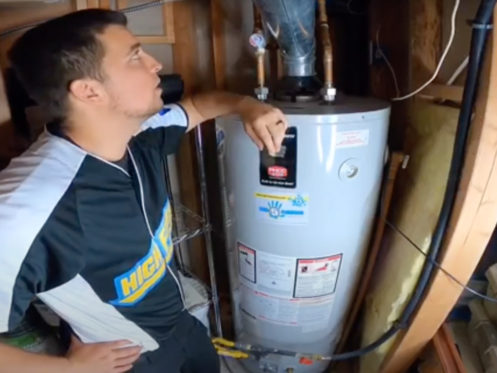What're your thoughts regarding What Kind of Maintenance Do Water Heaters Need??

Hot water is essential for day-to-day comfort, whether it's for a refreshing shower or washing dishes. To ensure your hot water system runs efficiently and lasts longer, regular maintenance is key. This article gives sensible tips and insights on just how to keep your home's warm water system to prevent disruptions and pricey fixings.
Introduction
Preserving your home's hot water system might appear complicated, however with a few straightforward actions, you can ensure it operates efficiently for many years to come. This overview covers whatever from understanding your warm water system to do it yourself maintenance tips and recognizing when to contact professional aid.
Value of Maintaining Your Warm Water System
Routine maintenance not just prolongs the lifespan of your warm water system but additionally guarantees it operates successfully. Overlooking upkeep can bring about lowered effectiveness, higher energy costs, and also premature failing of the system.
Indicators Your Hot Water System Needs Upkeep
Understanding when your hot water system needs focus can stop major concerns. Watch out for indications such as irregular water temperature, strange noises from the heater, or corroded water.
Flushing the Water Heater
Purging your water heater gets rid of debris buildup, boosting effectiveness and lengthening its life.
Monitoring and Replacing Anode Rods
Anode poles avoid deterioration inside the storage tank. Inspecting and changing them when worn is crucial.
Facility Issues Calling For Expert Aid
Examples consist of major leakages, electrical troubles, or if your hot water heater is regularly underperforming.
Regular Professional Upkeep Advantages
Specialist maintenance can consist of comprehensive examinations, tune-ups, and guaranteeing conformity with security criteria.
Examining and Readjusting Temperature Setups
Adjusting the temperature level setups guarantees optimum performance and safety and security.
DIY Tips for Maintenance
You can execute several upkeep tasks yourself to maintain your hot water system in top problem.
Checking for Leakages
Regularly examine pipelines and connections for leaks, as these can bring about water damages and higher expenses.
Recognizing Your Hot Water System
Before diving right into upkeep tasks, it's practical to understand the basic elements of your warm water system. Generally, this includes the hot water heater itself, pipes, anode rods, and temperature controls.
Month-to-month Maintenance Tasks
Routine month-to-month checks can help catch small concerns prior to they escalate.
Evaluating Stress Alleviation Valves
Examining the pressure relief valve ensures it works appropriately and prevents excessive pressure accumulation.
Protecting Pipelines
Shielding warm water pipelines reduces heat loss and can save power.
When to Call a Specialist
While do it yourself upkeep is helpful, some concerns call for expert know-how.
Final thought
Routine maintenance of your home's hot water system is vital for effectiveness, long life, and price financial savings. By complying with these ideas and understanding when to seek professional help, you can make certain a trustworthy supply of hot water without unexpected disruptions.
How to Maintain an Instant Hot Water Heater
Before tinkering with your hot water heater, make sure that it’s not powered on. You also have to turn off the main circuit breaker and shut off the main gas line to prevent accidents. Also turn off the water valves connected to your unit to prevent water from flowing into and out of the appliance. 2. When you’re done, you have to detach the purge valves’ caps. These look like the letter “T†and are situated on either side of the water valves. Doing so will release any pressure that has accumulated inside the valves while at the same time avoid hot water from shooting out and burning your skin. 3. When the purge valves’ caps are removed, you have to connect your hosing lines to the valves. Your unit should have come with three hoses but if it didn’t, you can purchase these things from any hardware or home repair shops. You can also get them from retail stores that sell water heating systems. Read the user’s manual and follow it to complete this task properly. When the hosing lines are connected, open the purge port’s valves. 4. You should never use harsh chemical cleaners or solutions when cleaning your unit. Make use of white vinegar instead. It should be undiluted and you’ll probably use about 2 gallons. 5. Now flush your water heater. This task should probably take about 40 minutes. We can’t give you specific directions for this because the procedure is carried out depending on the type, model and brand of your heater. With that being said, refer to the user’s manual. 6. When you’re done draining the unit, you have to turn off the purge port valves again. Remove the hosing lines that you earlier installed on each of the water valves. Put the valve caps (purge port) back in their respective places and be very careful so as not to damage the rubber discs that are found inside these caps. 7. Now that everything’s back in place, check your user’s manual again to find out how to reactivate your water heating system. 8. Once it is working, turn one of your hot water faucets on just to let air pass through the heater’s water supply pipes. Leave the tap on until water flows smoothly out of it. https://www.orrplumbing.com/blog/2014/september/how-to-maintain-an-instant-hot-water-heater/

I recently found that blog posting about What Kind of Maintenance Do Water Heaters Need? while perusing the search engines. Feel free to take the opportunity to share this page if you appreciated it. Thanks for taking the time to read it.
Get Quote Now